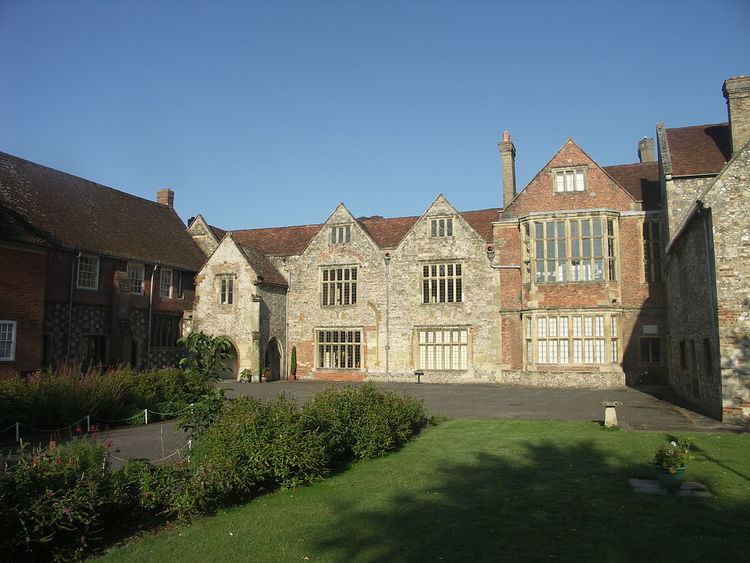Established 1860 Phone +44 1722 332151 | Type History museum Director Adrian Green | |
 | ||
Address The Kings House, 65 The Close, Salisbury SP1 2EN, UK Hours Closed now Saturday10AM–5PMSundayClosedMonday10AM–5PMTuesday10AM–5PMWednesday10AM–5PMThursday10AM–5PMFriday10AM–5PMSuggest an edit Similar Mompesson House, Arundells, Boscombe Down Aviation, Old Sarum, Wilton House Profiles | ||
The salisbury museum
The Salisbury Museum is a museum in Salisbury, Wiltshire, England. It houses one of the best collections relating to Stonehenge and local archaeology. Following rebranding in 2014, its name was simplified from the previous version, 'Salisbury and South Wiltshire Museum'.
Contents
- The salisbury museum
- Temporary exhibitions
- Rex Whistler archive
- Lake House meteorite
- The Wardour Hoard
- The New Wessex Gallery of Archaeology
- Other collections
- References
The museum is housed in The King's House, a Grade I listed building, where King James I of England was entertained in 1610 and 1613. Set in the surroundings of the Cathedral Close, the museum faces the west front of Salisbury Cathedral. Previously based at No 40-42, St Ann Street, where it had been founded in 1860 by Dr Richard Fowler, FRS, it transferred to its current location in the 1970s.
The original three-storey building with mullioned and transomed windows, ornate plaster ceilings and a fine oak-balustraded staircase, houses the main temporary exhibition gallery, with the ceramics gallery above.
The arms of James I's eldest son, Henry Frederick, Prince of Wales, can be seen in a window in the Wedgwood gallery upstairs.
The Director of the museum is Adrian Green.
Temporary exhibitions
Popular summer exhibitions since 2011 have featured artists who share a close connection with the locality.
Rex Whistler archive
A £350,000 grant from the National Heritage Memorial Fund (NHMF) was awarded in August 2013, to help save the personal archive of Rex Whistler. The Salisbury Museum hopes to purchase the archive, which contains over 1,000 items and is the only substantial collection of material relating to the artist.
Lake House meteorite
On 10 September 2012, a 90 kg meteorite, possibly the biggest to have ever fallen on the British Isles, went on display at the museum. For at least 80 years it sat near the front door of Lake House at Wilsford-cum-Lake near Salisbury. When the house was sold, the stone was confirmed as a meteorite by the Natural History Museum where it remained in storage for many years. Professor Colin Pillinger, known for his work on the Beagle 2 Mars spacecraft, had been studying a smaller meteorite from the Danebury Hill Fort in Hampshire and felt that there could be a connection between the two. The meteorite from Lake House was retrieved from storage and although the two objects were found to be unrelated, Professor Pillinger continued with his study of the larger meteorite.
The meteorite landed on earth some 30,000 years ago and was apparently preserved by the frozen conditions during the last ice age. In normal circumstances the meteorite would have disintegrated, but the cold and ice helped preserve it. Thousands of years later, in the Stone or Bronze Age, it is thought that the meteorite was built into a burial mound close to Lake House. The local chalk environment would again have helped to preserve it. The meteorite may have been unearthed in the 19th century by Edward Duke, a previous owner of Lake House who was an antiquarian who excavated burial mounds nearby and had his own private museum. Photographic evidence shows it on the doorstep of Lake House at the time the property was owned by the brewer Joseph Lovibond, Mayor of Salisbury in 1878-79 and 1890-91.
The Wardour Hoard
In November 2011 the Museum displayed a hoard of over 100 copper alloy objects which were over 2,700 years old and dated to the late Bronze Age and early Iron Age. It was found near Wardour by a metal detectorist, and consists of tools - axe heads, chisels, sickles, gouges, as well as spearheads, daggers, knives, swords and scabbard fittings. It was the most important hoard to have been found in Wiltshire since the discovery of the Salisbury Hoard in the 1980s.
The New Wessex Gallery of Archaeology
In June 2012, the Heritage Lottery Fund (HLF) awarded Salisbury Museum a grant of £1,794,600 towards the development of a new Archaeology of Wessex gallery. The new gallery opened in the summer of 2014 and is of international importance, telling the story of Salisbury and the surrounding area from prehistoric times to the Norman Conquest, and showing why Salisbury has a unique place in history. The museum's collections include some of the most important archaeological finds in Britain, including artefacts from the Stonehenge World Heritage Site, the Pitt Rivers Wessex Collection and the Amesbury Archer.
Other collections
The Museum has an art collection of over 4,000 paintings, prints and drawings, representing local personalities, topographical scenes, special events and everyday life, or created by local artists of note. An outstanding Costume Collection includes clothes relating to the people in and around Salisbury over the past 250 years, including wedding dresses, uniforms, formal wear and lace samples produced by Downton Lace. The Museum also has an outstanding collection of ceramics. Local Verwood and Wiltshire Brown ware is represented alongside the celebrated Wedgwood, Bow and Chelsea potteries.
